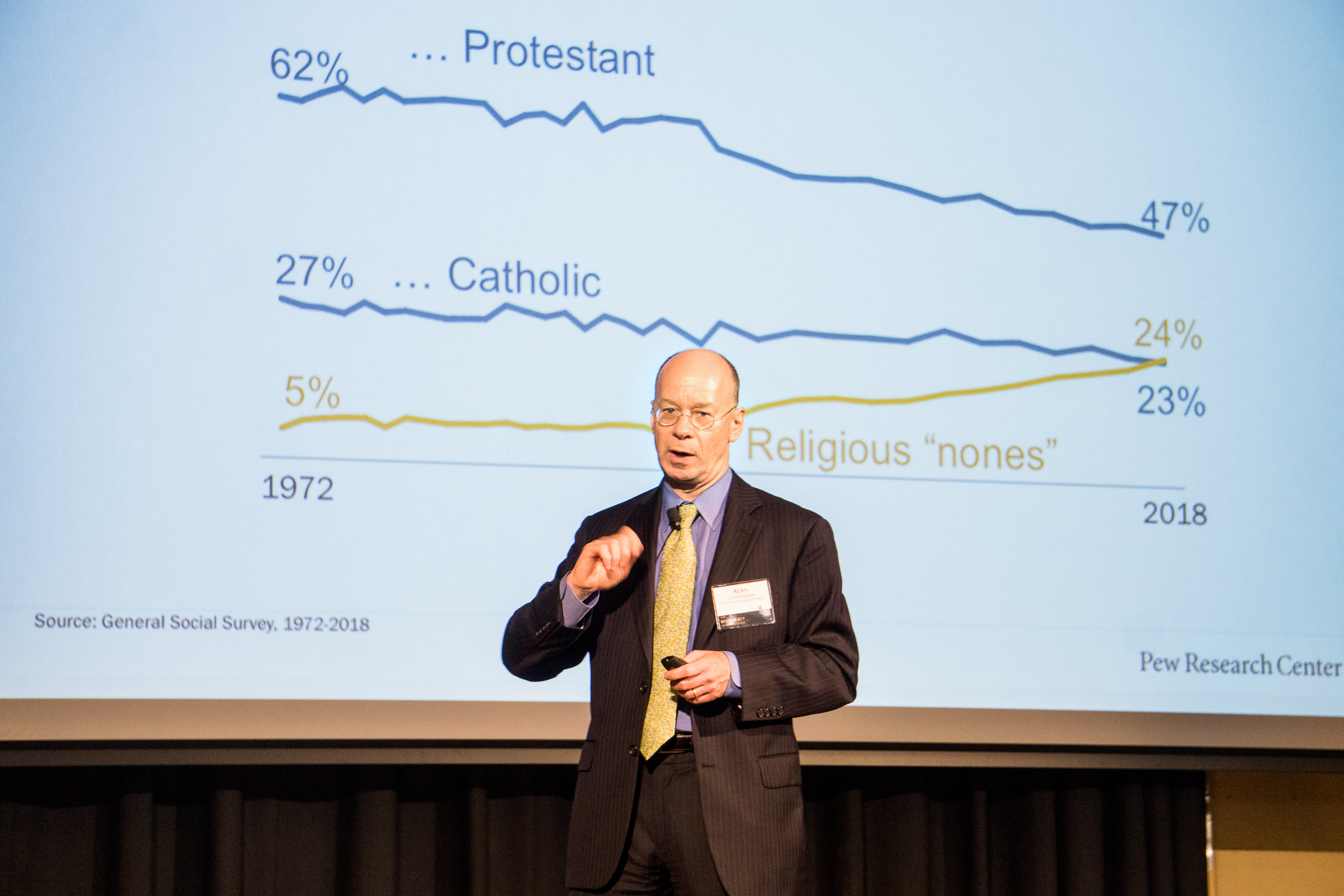Alan Cooperman educates his audience about religion in America during the first honors colloquium. Photo by Autumn Walter.
Alan Cooperman kicked off this year’s Honors Colloquium on Religion in America this past Tuesday, with his lecture exploring the diversity of religion and spirituality in the United States and how it plays a role in culture, politics and civic engagement.
Cooperman is the director of Religion Research at the Pew Research
“If you go around the world, asking people questions about religion, you cannot but be struck by how religious, in comparative terms, the United States is,” Cooperman said.
According to Cooperman, the religious community is imbued with spiritual tradition. However, religion is not just about beliefs and instead, sociologists classify religion through belonging, behaving and believing.
Cooperman showed the audience graphs on each topic he presented on, giving a visual representation to each point he made.
Through surveys taken in 102 countries around the world on the percentage of adults who say they pray daily and the 2015 per capita gross domestic product, the Pew Research Center discovered that in poorer countries, people pray more often, and in wealthier countries, daily prayer is less frequent.
Cooperman stated that the U.S. is the only country with both above-average GDP per capita and above-average frequency of daily prayer, revealing that America can be defined as a religious country.
However, despite the U.S. being a religious country, there is and has been a decline in religion within American life.
“While the United States is a very religious country, there is mounting evidence that religion is in decline in the United States today, in a number of important ways,” Cooperman stated.
Within the U.S., Cooperman said that in 2007, 78 percent of U.S. adults identified as some denomination of Christian. However, by 2014, it was down to 71 percent and in 2018-2019, only 65 percent identified as Christian, resulting in about a 1 percent decline per year. On the other hand, non-Christian faiths, such as Hindu, Muslim
However, the most significant trend in religious composition of the U.S. is the rise of the “Religious Nones,” or the religiously unaffiliated.
“Those who say they are atheist, agnostic or nothing in particular, those are the ones I’m characteristics as ‘none,’” Cooperman said. “It doesn’t mean they have no religion, it means they’re not identifying with any of those other religions.”
In 2007, 16 percent of the U.S. population identified as “religious nones,” and in 2019, 26 percent of the U.S. population identify as religious nones, on average, a 1 percent increase each year.
Cooperman broke down the “nones,” debunking common assumptions and statements about the trend.
“The first thing to realize is that this is happening all over the country, in every racial and ethnic category, it’s happening among men and women, it’s happening in the South as well as in the Northeast, it’s happening among college graduates and among those who only have high school degrees,” Cooperman said. “It’s a broad based social change.”
Cooperman qualified his statement by saying that while the religious nones are not always devoid of religion, they are much less religious than those who are affiliated with a specific religion.
“I’ve interviewed people around the world and I’ve never never met any person who is absolutely without any beliefs or practices that one may think of as religious or spiritual or related to the supernatural,” Cooperman said. “I’m not saying that it doesn’t exist, I’m saying that it is remarkably rare.”
According to the Pew Research Center’s studies, these changes in religious affiliation are generational, with the percent of people who identify as religiously unaffiliated in the silent generation around 11 percent and the percentage of millennials around 35 percent.
“The pattern is the younger generations are less religious on all the standard markers, and they aren’t more spiritual by any way that we have of measuring spirituality,” Cooperman said.
Along with this, no generation has become more religious as time goes on and although there are outliers who do begin to go back to their religious roots or begin affiliating with a religious institution, the pattern in research has shown that the majority of people are becoming unaffiliated with religion.
Cooperman came to a close on his lecture by stating the theories behind the growth of the religious nones which are composed of four points: politics, marriage, bowling and affluence. These hypotheses state that the rise of the religious nones is a backlash in regards to religion in politics, higher rates or people who are not married, joining organizations that have a community, and secularization.





